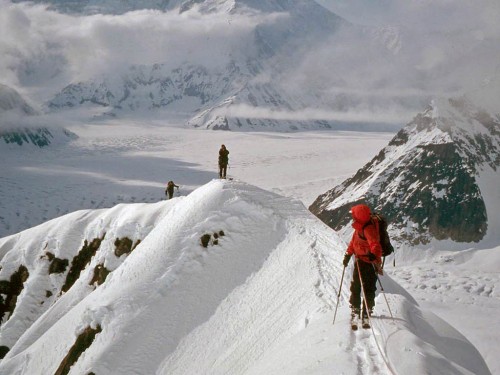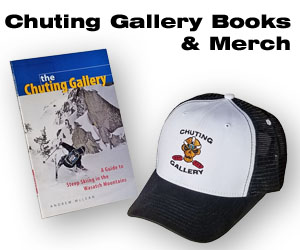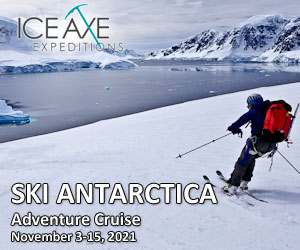Avalanche Avoidance – Part III
Snow is stable roughly 95% of the time, but the remaining 5% is often the most desirable time to go skiing, like right after a big phat powder dump on a bluebird day. Avalanche safety takes years of practice and as much as anything else, it is about developing avalanche eyes for what will slide, how far it will go and what are your options. Ernie Buehler, a guide at the prestigious Canadian Mountain Holidays heliskiing operation has guided thousands of clients through millions of feet of notoriously tricky terrain for over 30 years and only been caught in one slide. How? Patience, responsible terrain selection and more patience still. You have to want to avoid avalanches.

- Taking the morale high ground on avalanches by staying above their starting zone. Thunder Mountain, Alaska Range, AK. 2003
Between new safety technology and changes in attitudes, people are venturing into more committing avalanche terrain than ever before. In times past, avalanche education was as simple as telling skiers to stay out of avalanche terrain, which is still taught in parts of the world. It’s not a bad idea, but also not reality. What was once considered insane terrain is now skied before breakfast without a second thought. Skiers are becoming much more educated about avalanche danger, but at the same time they are cutting the safety margins down to the bare minimums.
______________________
For 15% off on a Patagonia Light Smoke Flash Jacket from Backcountry.com, click the photo below…
Category: 07 Avalanche Avoidance










Andrew,
I really don’t think that skers/boarders are that much better avalanche educated these days (and I teach avalanche safety courses). I think that they are just more willing to take greater and greater risks. I think that they do this because they think the rescue technologies are better, avalanche center forecasts are better and the “Hay, everyone is skiing this kind of stuff additude” via media coverage.
Halsted
Hi Halsted,
I think movies, magazines and websites have definitely contributed to encouraging people to get into steeper terrain, but I think they’ve also helped educate people about avalanches. It’s common to see avalanche safety videos, books or columns in magazines nowadays. It’s one thing if people choose to ignore them, but at least they are out there!
“It’s one thing if people choose to igbore them, but at least they are out there!”
What???
“They” as in avalanche safety videos, books and magazine articles are readily available. You can lead a horse to water, but you can’t make him drink, or, you can lead a skier to a slope, but you can’t make him think.
OK…. It just sounded kind of strange. To me it sounded like, “go ahead and ignore the safety information, but get out there at anyway.” Sorry….
I’d rather see it where if someone doesn’t have any avalanche education, at least then they might go with and see their friend(s) thinking and doing the usual safety protocols.
But, the younger gang seems these days to want to forget the “apprenticship phase.” Its like they want to strait to the “master phase.”
I see this a lot when folks come up to me and say, “I have my Level 2 certification, blah, blah, blah.” I usually say, “So what.”
Its more like the courses are meritbadges then real learning experience. First off, there is no “certification,” in the US level course. Hardly any have a pass fail test (AAA’s AvyPro course does) like a first aid certification; where they test both knowledge AND skills.
What I really try and leave my students with, in my avalanche course is this thought = “You have taken an avalanche course and now you need to learn about avalanches by gaining experience in the field. Go slowly so you can learn safely.”
Cheers,
Halsted
Very true. The best thing that can happen to a person who is new to backcountry skiing is to find a good mentor – often easier said than done.
Partners? Mentors? Tell me about it. Most of what I thought I knew came from the internet including books I bought, reports I read, pictures I studied…NNTAWWT esp when your teachers are seasoned, smelly, long lived backcountry skiers. It worked for nice, stable western NY where I never saw anyone else or their tracks. Then I moved here, took a level one course and got laid into by a particularly venerable old avi guy about skiing by myself. He’s right, its not the safest way to go. And he did the incident report on the slide down here that killed 4 so he knows just how tricky my mountains can be.
But I still haven’t found anyone here to ski with except people who look to me as the “expert”. And since I’m not I won’t take them. Besides they don’t have b/s/p nor understand the need for education to avoid having to use them.
But being out there by myself with my eyes open and my mind engaged has taught me more in 2 seasons than I ever thought there was to know. Meadow skipping has its rewards and for me its knowing that I do know what I’m doing, that my safety depends upon my own actions. I’m alive because I’m a conservative, scared old woman out in big steep mountains with a notoriously unstable snow pack. A classroom experience every day if I’m paying attention. And since paying attention is how I keep the scared down to a managable roar I do.
Its chic to ski outtabounds. Except for the uphill slogging part and the “nope can’t ski that today” part, and the “oooh damn I broke a binding” part.
Send your unattached middle aged bc skier men friends down here. I need partners. I got bigger things I want to ski and I can’t until I find trustworthy folks to go with.
Happy polygamy day. How’s all your wives?
rl
The wives are doing well – all six of them.
Finding good partners is hard, especially as you tend to find them unlikely places, like running races or mountain biking festivals. By the time the snow comes, it’s like High School dance – if you don’t have a partner, it is too late.
I’m a fan of the fortune cookie concept of “Practice Saying Yes.” Your immediate partner/location may not be ideal, but it may lead to someone else who is.